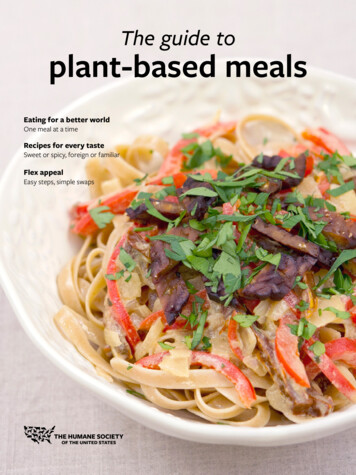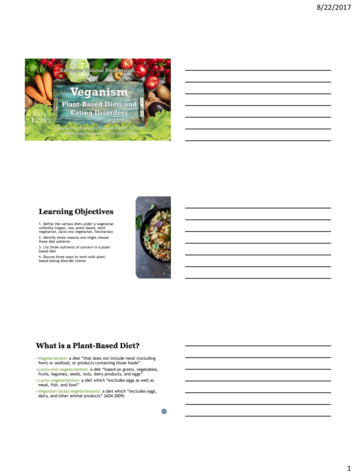
Transcription
The guide toplant-based mealsEating for a better worldOne meal at a timeRecipes for every tasteSweet or spicy, foreign or familiarFlex appealEasy steps, simple swapshumanesociety.org/meatfree 1
Standing up for the planet,better health and animals,one bite at a time.Thanks for your interest in the HSUS’ Food ServiceProfessional’s Guide to Plant-Based Meals. There are somany reasons millions of people are choosing to eat moreplant-based meals. Some do it for their health. Others doit for the health of the planet. And many do it to help animals. Meatless eating is gaining in popularity, with 133 million Americans eating vegetarian meals at least once a week.Popular programs like Meatless Monday and Lean and GreenDay have helped institutions provide and market meatlessoptions to their guests with great success. And countlessothers are finding innovative ways to keep up with this growing market opportunity.Adding more plant-based meals to your menus keepsguests seeking healthier options coming back, demonstratesyour organization’s commitment to sustainability and addsvalue and variety to your food service offerings.In this guide, you’ll learn why eating plant-strong is sweeping the nation, what to serve and how to promote these options. It need not be an all-or-nothing endeavor. Go at yourown pace and do what works best for your institution.No matter your reason for helping your guests choosemeatless options, feel good about your decision knowingthat you’re making a positive difference in the world. TheHSUS stands behind you, ready to assist.Karla Dumas, RDN, LDNSenior Manager, Farm Animal ProtectionThe Humane Society of the United Statesforwardfood@humanesociety.org
Eating for a better worldFactory farm survivors reveal the faces behind our foodA PIG. A HEN. A BULL. Just three among the 9 billion landanimals who suffer each year on U.S. factory farms. All werenameless “production units” bound for slaughter—untilthey escaped and came into their own.COVER: MEREDITH LEE/THE HSUS. OPPOSITE PAGE: KATHERINE DUMAS. THIS PAGE, FROM TOP: OLIVIA SCHLOSSER-HOGUE; MARJI BEACHSOME PIGThe pig was headed to her death in a two-level truckcrammed with hundreds of animals. Fresh from severalmonths of “finishing,” when young pigs are packed in pensand fed as much as they can eat, she weighed 220 pounds—stocky and thick-legged. A tattoo over her rib cage identifiedher as one of more than 1,000 animals raised on an Ohiofactory farm, the offspring of a sow kept tightly confined ina gestation crate—a mother the pig had known only duringthe few weeks she was allowed to nurse.The young pig’s existence might have ended as an entry ona company ledger. Except that she tumbled out of the truckand onto the pavement. When volunteers from Happy TrailsFarm Animal Sanctuary came to her aid, she got a name—Scarlett—along with the recognition that she was more thanbacon.Adopted by Happy Trails employee Olivia SchlosserHogue, Scarlett became a mother to three smaller rescuedpigs. And when the neighbor’s 3-year-old boy visited, shewatched over him too, making sure he was all right if hefell. Every morning, she has a special greeting for SchlosserHogue and her husband, pushing her nose close to theirfaces and making a loud huffing sound pigs reserve for individuals above them in the social hierarchy. In winter, she liesin the straw, waiting for people to join her there. “There’ssomething really calming about her,” says Schlosser-Hogue.“She has always been the sweetest pig ever.”THE HIGH-FLYING HENThe hen’s chance came as she listened to the panicked uproar of 80,000 birds housed five to a cage in a Californiawarehouse. At one end of the building, workers were rippinghens from cages to send them to slaughter because the property on which the farm operated was being sold. Torn fromthe wire mesh, some lost wings and some lost feet. At theother end of the building, rescuers from a nearby farm animal sanctuary were gently lifting 2,000 chickens from theircages. The 1½-year-old hen, who was past peak egg production age and would normally have been killed for low-grademeat, fell among the fortunate.
Named Sarah, she was placed in a flock of 50 rescuedbirds at Animal Place sanctuary. For the first time, she couldrevel in sunshine and grass. After living in a cramped cage, ittook Sarah a few moments to realize she could walk. Then,“she would stand up and fluff up her feathers and run as fastas she could and take to the air,” recalls education managerMarji Beach. “She got the other birds doing it.” When her atrophied muscles recovered, Sarah roosted on the top perch.your leg in greeting. We call him and he comes. We don’teven have to corral him.”Before, the bull was kept penned indoors. Now he runsaround outside in a large field, kicking up his legs.“You look into any farm and there are thousands of animals,” says Coston. “But if you pull any one of those animalsout, they are who they are.”THE EBULLIENT BULLThe bull made his break when a semitrailer hauling 34 cattleon an Indiana interstate slammed into another truck andburst into flames. Fifteen surviving cattle were rounded up.But the bull, though severely burned, refused to be recaptured. The 2-year-old Holstein led police and others on a12-hour chase before being taken to the local animal shelter.Jay ended up at Farm Sanctuary in New York. Whenhe arrived, staff removed his rope and halter. He wasn’tyet fully recovered, but he could move about in hisspacious stall and touch noses with other cattle.“Giving him that freedom really sealed the deal,” saysFarm Sanctuary’s Susie Coston. “He’s blossomed. He licksLarge-scale animal agribusiness causeswidespread suffering, but the consequences don’t end there. Here are even morereasons to reduce or eliminate animalproducts from our diets:GREENHOUSE GAS EXPLOSION: Many aspects of themeat, egg and dairy industries—not just the raising of animals, but feed crop production, deforestation, energy useand transportation of animals and animal products—play aprominent role in climate change and are a leading greenhouse gas emitter.TOXIC WASTE: Animals confined in U.S. factory farms produce three times more waste than the entire U.S. population.This manure can contaminate water supplies and emit harmful gases such as hydrogen sulfide, ammonia and methane.2 Guide to Plant-Based MealsDOWN THE DRAIN: According to the EnvironmentalProtection Agency, water quality concerns are most pronounced in areas of intensive crop cultivation and concentrated farm animal production facilities. Animal agribusinessalso consumes enormous amounts of water: A pound of processed animal protein requires up to 26 times more water toproduce than a pound of soy protein.PUBLIC HEALTH PERILS: Farm animal waste has causedoutbreaks of E. coli, salmonella and other pathogens thatcontaminate food and drinking water. Studies have alsofound that people who live near factory farms disproportionately suffer from excessive coughing, diarrhea, burningeyes, headaches, nausea and respiratory problems.ANTIBIOTIC RESISTANCE: To keep animals alive in overcrowded, unsanitary and stressful living conditions, factoryfarms use massive amounts of antibiotics—many of the samedrugs used in human and veterinary medicine. Antibioticsand antibiotic-resistant bacteria can be found in the air,groundwater and soil around farms and may contaminatemeat, eggs and dairy products.THIS PAGE: FARM SANCTUARY. OPPOSITE PAGE: KATIE DUMASChoose meat-free
Karla's cornerHealth benefits of vegetarian foodsBy Karla Dumas, RDPowering up with plant-strong foodsPLANT-BASED FOODS ARE FULLOF IMPORTANT NUTRIENTS:WHAT DOES A HEALTH-PROMOTING, BALANCEDMEAL PATTERN LOOK LIKE? According to nutrition andhealth experts, it’s full of plant-based foods like beans,nuts, fruits, vegetables and whole grains with little to nosaturated animal fat or cholesterol (which is solely foundin animal products). Unfortunately, the Standard AmericanDiet does not typically reflect these recommendations.Most Americans don’t eat the recommended daily servingsof fruits and vegetables, and four of the leading causes ofpreventable death—heart disease, certain cancers, strokeand Type 2 diabetes—are strongly associated with diet.As we learn more about how food can prevent chronicdisease, more experts and public health organizationsrecommend incorporating meat-free meals, including theAmerican Heart Association, National Cancer Institute andWorld Health Organization, as well as the U.S. dietary guidelines. People who eat completely meatless diets are half aslikely to become hospitalized or require medications andhave even been documented as living longer. The Academyof Nutrition and Dietetics notes that these diets are “appropriate for all stages of the life cycle, including pregnancy,lactation, infancy, childhood, adolescence, older adulthoodand for athletes.”IRON: Green, leafy vegetables; grains (rice, oats, enriched cereals); soy products (soy milk, tempeh); nutsand dried fruits are all good sources of iron.CALCIUM: Plant-based sources include fortified dairyfree milks (such as soy, rice and almond) and orangejuice, greens, beans, nuts and seeds. Fortified dairy-freemilks typically contain the same amount of calcium asdairy, but none of the saturated fat, cholesterol or lactose, and are a better source of iron.OMEGA-3S: Flaxseeds, walnuts and algae oil DHAsupplements are healthy sources of omega-3 fatty acids, without the toxins (such as mercury) found in fishoil supplements.PROTEIN: Beans, nuts, seeds, soy products and wholegrains are excellent cholesterol-free protein sources.They also contain fiber, folate and health-promotingphytonutrients.Enjoying more meat-free meals, no matter your age,can lead to significant health benefits. People who eatmore plant-based meals consume more nutrients, such asvitamins A and C, folate, fiber and iron, and they have a higherintake of fruits and vegetables, which most Americans lack,according to the latest version of the Dietary Guidelines forAmericans. Americans typically consume far more proteinthan they need, and meeting daily protein and nutrientneeds with appropriately planned meat-free meals can bea cinch. The great Carl Lewis transitioned to an entirelyplant-based diet to prepare for the World Championships,where he said he “ran the best meet of his life.” In the 2016Summer Olympics, vegan Kendrick Ferris was the onlyAmerican weightlifter to qualify, setting a new personal andU.S. record in the Olympic trials.Choosing more meat-free meals is an easy, cost-savingand delicious way to promote overall health. Join millions of Americans in discovering the joys and benefitsof eating more plant-based meals. For recipe ideas, eatfree 3
Flex appealFOR SOME, THE IDEA OF OVERHAULING a lifetime of dietary habits can be intimidating. As Josh Balk, vice presidentof the HSUS Farm Animal Protection campaign, says, “It'sunderstandable that people may choose not to switch theirdietary habits overnight.”But it doesn’t have to be an all-or-nothing proposition.Whether your primary incentive is helping the environment,improving animal welfare or addressing health concerns, youcan take a significant first step by becoming a flexitarian. Theterm blends “flexible” and “vegetarian” to describe those whotake a part-time approach to avoiding meat.“A flexitarian is waking up every day and trying to bemore vegetarian,” says Dawn Jackson Blatner, spokeswomanfor the Academy of Nutrition and Dietetics and author ofThe Flexitarian Diet. “It’s not going to be perfect; it’s aboutprogress.”In promoting conscientious eating, the HSUS embraces the Three Rs—reducing the consumption of animal4 Guide to Plant-Based Mealsproducts; refining the diet by avoiding foods created in theworst production systems (for example, switching to cagefree eggs); and replacing animal products with plant-basedfoods. Popular programs such as Meatless Mondays—adopted by colleges and school districts around the country—havehelped people see, one day a week, how easy and deliciousvegetarian cuisine can be. And Vegan Before 6, developed byNew York Times best-selling author Mark Bittman, takes it onestep further by promoting the daily consumption of plantbased products until dinnertime. (Read more about Bittmanon p. 6.)Whatever the approach, finding tasty new foods can helpwith the transition, especially when recreating your favoritecomfort foods. Plant-based cheese sauces, like that in therecipe on the following page, can offer the rich, creamy flavorof dairy cheese—minus the hormones and antibiotics. And thechickpea sliders are packed with protein and are so flavorfulthat you'll never miss the animal products on your plate.THIS PAGE: DAVID SACKS/GETTY. OPPOSITE PAGE, FROM TOP:MICHELLE RILEY/THE HSUS, LANCE MURPHEY/AP IMAGES FOR THE HSUSWITH BIG STEPS OR BABY STEPS, YOUCAN PROGRESS TOWARD A HEALTHIER,MORE HUMANE DIET
Creamy Cheese SauceServes 82 cups white potatoes, peeled and cubed1 cup carrots, peeled and chopped1/3 cup olive oil1/2 cup water, reserved from boiling potatoes and carrots1 tablespoon lemon juice1/2 cup nutritional yeast1 teaspoon salt1/2 teaspoon garlic powder1/2 teaspoon onion powderDash cayenne pepper, optional1. BOIL potatoes and carrots until tender,about 20 minutes.2. DRAIN, reserving 1/2 cup of the liquid.3. COMBINE all ingredients in a blenderand blend until smooth.Cook elbow noodles according to package directionsfor mac and cheese or serve over chips, beans, lettuce,tomatoes and your favorite toppings for nachos.Chickpea SlidersServes 91 cup onion, diced small1/8 cup fresh garlic, minced1 tablespoon oil1 (15-ounce) can garbanzobeans, drained and rinsed1/4 cup walnuts1 tablespoon cilantro1/2 cup all-purpose flour1/4 teaspoon cumin1/2 cup olive oil, divided1 teaspoon salt1 teaspoon pepper1. IN A MEDIUM PAN, add 1 tablespoon oil and sweat onionsand garlic until soft, about five minutes, then transfer to a largebowl.2. PROCESS CHICKPEAS in food processor untilbroken into small pieces, being careful not to overprocess.3. ADD chickpeas, walnuts, cilantro, flour, cumin, 1/4 cup of oil, saltand pepper to bowl with onions and garlic and mix well.4. SCOOP 1/4 cup of the mixture at a time and shape into patties.5. WARM remaining oil in a medium pan. Cook patties in oiluntil golden brown, flipping once.6. SERVE on bread of choice and add toppings as desired.humanesociety.org/meatfree 5
Flexing your food choicesReducing your consumption of animalproducts doesn’t require a drastic dietoverhaul. With a few simple steps, youcan become a full-fledged flexitarian—a part-time vegetarian.Food writer embracesflexible diet strategyThe acclaimed author of How to Cook Everything,Mark Bittman was suddenly being told to cut back on the“everything.”“Look,” he remembers his doctor telling him, “you’reoverweight, your cholesterol’s higher than it used to be,your blood sugar’s higher than it used to be, you havesleep apnea, you have a couple other problems. Youshould probably become a vegan.”Bittman resisted.“Well, figure something out,” his doctor added.“Figure something out in that direction.”And so Bittman devised an approach he called VeganBefore 6: avoiding meat and other animal products untildinnertime each day.Fortunately, he had plenty of recipes to drawon. Concerned about the environmental impactsof mass meat production, and sensing shifting diets in thegeneral public, the former New York Times columnist hadalready written How to Cook Everything Vegetarian.For four years, his flexitarian routine has stuck.“The first thing is eliminate the processed food,eliminate the fast food, eliminate the junk,” says Bittman,who lost 30 pounds and resumed running marathons.“But the second thing is just to remember that anytime that you choose an unprocessed plant over anythingelse, you’re moving in the right direction. And whetherthat’s once a day, or twice a day, or five times a day, that’sthe direction to move in.”CHECK OUT Bittman’s recipe for grilled eggplant andscallions with miso rice at humanesociety.org/meatfree.6 Guide to Plant-Based MealsEXPLORE THE UNKNOWN: Visit your communityhealth food store or your local grocery store’s naturalfoods aisle to check out some of the fantastic vegetarian items on the market. Give international recipes atry: Many of the world’s cuisines have classic vegetariandishes that will introduce your tastebuds to a world ofnew flavors and textures.SATISFY YOUR CRAVINGS: Redirect your appetite formeaty flavors to foods like walnuts, soy sauce, mushrooms,tomatoes and sweet potatoes. And try the many plant-basedproteins on the market, from vegetarian steak strips to delislices to barbeque “ribs”—you may like them even betterthan the animal-based versions.DIVE INTO DAIRY-FREE: If you have a driving desire fordairy, check out the delicious plant-based options availableat most grocery stores, including dairy-free cheese (available in blocks, slices and shreds), milk, sour cream, creamcheese and ice cream.KEEP IT HEALTHY: Don’t load up on processedfoods, sweets or dairy products. Fresh fruits and vegetables with whole grains and plant-based proteins likebeans, lentils, peas and nuts should be your mainstays.KUDOS TO YOU: Pat yourself on the back as youtransition to a healthier way of eating, and rememberthat you’re helping to make the world a better place,simply by enjoying vegetarian fare.THIS PAGE: SALLY STEIN. OPPOSITE PAGE: NICOLE HILL/GETTY IMAGESThe part-time vegetarianREINVENT THE FAMILIAR: Swap the chicken in yourburritos for black beans or grilled vegetables. Insteadof sour cream, spoon on some guacamole or salsa.Replace the meat sauce on your pasta with spicy marinara, and try vegetarian burgers and dogs. Substituteapplesauce, flax meal, mashed bananas or Ener-G eggreplacer for eggs when preparing baked goods—you’ll getall the taste without the cholesterol (see p.12 for moredessert tips).
Dining out, veg-styleBUTTERNUT SQUASH RAVIOLI smothered in cashewcream sauce. Seasonal fresh greens with avocado, pine nutsand kalamata olive vinaigrette. Candied pumpkin seeds andcaramel sauce over locally grown baked apples. The messagein Candle 79’s menu is clear: There’s never been a more delicious time to choose vegetarian.“People are shocked just floored really that the food isthat delicious,” says Benay Vynerib, chief operating officerof the upscale, all-vegan eatery and wine bar and its sisterrestaurant, Candle Café. Exceeding all expectations and inspiring healthier living is something the Candle restaurantsare known for.Not long ago, if you craved a healthy, meat-free meal, yourolled up your sleeves and started chopping. Dining out wasa challenge, and seldom satisfying. But in recent years, meatfree meals have become a mainstay of restaurant offerings.Routinely, surveys by the National Restaurant Associationlist vegetarian and vegan entreés as two of the industry’s“hottest trends.” While fast-food chains and steakhousesadd veggie dishes to their menus, fine dining spots like theworld-famous Candle 79 in Manhattan’s Upper East Side aremincing stereotypes of plant-based cuisine.“I’ll never forget this father of the bride,” Vynerib says.“He was adamantly convinced he wasn’t going to like thefood. And he’s been back several times.”From upscale vegan restaurants to fast-food chains likeBurger King, White Castle and Chipotle, it's never beeneasier to eat meat-free than it is now!humanesociety.org/meatfree 7
Hearts of Palm andCauliflower CevicheCeviche, a dish known for its refreshing flavors andunique textures, now comes to you in an entirelyplant-based form thanks to hearts of palm and cauliflower. Various kinds of seafood have found theirway into ceviche over the years, but for this recipe,we rely on multilayered hearts of palm. We canmimic both scallops and calamari rings by separating the center of the palm heart from its outer ring.These provide the chewy element of our plant-baseddelight. Next up? Miraculous cauliflower. By choppingraw cauliflower into small pieces, we can pack a softcrunch into the dish, ensuring that this plant-basedceviche delivers on both texture and freshness.Eddie Garza, HSUS senior manager of food and nutrition, has long loved cooking. He spent the majorityof his childhood in the kitchen with his grandmother,who taught him everything he knows about Mexicancooking. Here Eddie shares a recipe for ceviche fromhis ¡Salud! Vegan Mexican Cookbook.Serves 62 large Roma tomatoes, diced into cubes1 cup chopped red onion1 cup chopped cilantro2 jalapeño peppers, seeded and chopped1 cucumber, diced into cubes1 cup cauliflower, finely chopped1 (14-ounce) can hearts of palm, drained, centers pushedout, cut into slices1 tablespoon olive oilJuice of 2 lemons1 avocado, peeled, seeded, diced into cubesSaltBlack pepper1. IN A LARGE BOWL, combine the tomatoes, onion,cilantro, jalapeños, cucumber and cauliflower. Mix well.2. ADD the hearts of palm, olive oil and lemon juice, and mix.3. ADD the avocado, season with salt and pepper,and toss gently.4. CHILL for at least 60 minutes before serving.8 Guide to Plant-Based Meals
Tips for dining outWORLD EXPLORERCHALLENGE: Eating out is your favorite pastime, but you’refeeling a bit bored with the pastas at Italian restaurants andthe veggie burritos and guacamole at Mexican eateries.SOLUTION: Introduce your taste buds to some newflavors. Chinese, Indian, Ethiopian, Japanese, MiddleEastern, Thai and other international restaurants offer aplethora of vegetarian dishes.TOP CHEF TIP-OFFCHALLENGE: You’re taking your parents to their favoriterestaurant, where the menu hasn’t changed since the Fordadministration. You envision a bowl of iceberg lettuce witha tomato slice and a few croutons. Maybe a side of fries or aspaghetti plate from the kids’ menu if you’re lucky.SOLUTION: Call ahead and see what the chef can offer for avegan meal, suggests Benay Vynerib, chief operating officerof New York City’s Candle Café and Candle 79 restaurants.“Chefs are more than willing to accommodate, but they lovethe heads-up, because it gives them the opportunity to be creative and to show you that they care.” Also check with servers;many are more than willing to accommodate requests or steeryou toward options not listed on the menu.UNFAMILIAR TERRITORYCHALLENGE: You’re on the road, and your bag of trail mix isgetting light. But the highway billboards only point to chaineateries and fast-food joints.SOLUTION: No need to panic. Chain restaurants like WhiteCastle, Johnny Rockets, Denny’s and Red Robin offer mouthwatering veggie burgers with all the fixings. Even fast-foodjoints like Taco Bell, Chipotle and Fazoli’s feature meat-freeitems. With some advance planning (or a good GPS), a roadtrip can also be a great opportunity to visit restaurants youwon’t find at home. Vegetarian eateries are becoming increasingly popular. Add some to your itinerary and getting to yourdestination might be the highlight of your trip. You can alsodownload apps like Happy Cow that point you to the closestvegetarian-friendly establishments.OPPOSITE PAGE, FROM TOP: SYLVIA ELZAFON/FOR THE HSUS; ALEXANDER LUNA; THIS PAGE: JOHN GIUSTINA/GETTY IMAGESThough many restaurants are meeting thegrowing demand for healthier, more compassionate fare, you may still find yourselfin situations where a little creativity orforethought can help ensure a satisfyingdining experience. Here are some tips.humanesociety.org/meatfree 9
The spice of lifeA more humane diet can awaken yourFor longtime food writer and trained chef Kim O’Donnel,shifting her diet to include more vegetarian fare has been ajourney of delicious discoveries—not sacrifices.O’Donnel learned to recreate the “savoriness” of meatin vegetarian dishes by using ingredients such as mushrooms, soy sauce, smoked paprika and chipotle chiliesin adobo sauce. And she reveled in the challenge of making vegetables irresistible. “I’ve converted many a broccolihater after I served them my roasted broccoli pickup sticks,”she says.In her quest for successful recipes, the formertofu-avoider experimented until she developed twostandouts: pepita-crusted tofu and tofu barbecue.The latter took off after a friend suggested freezing tofu—making it more porous, like a “flavor sponge.” Both areamong the recipes in The Meat Lover's Meatless Cookbook,which O'Donnel wrote in part to help readers institute aMeatless Mondays program throughout the year.“I want people to cook,” O’Donnel says. “And I think thatthe more that we commit to cooking regularly, the moreaware that we become of where our food’s coming from andhow it’s raised and grown.”She also hopes to inspire readers to break outof the meat-and-potatoes rut—and discover whatthey’ve been missing at the farmers market and inthe international aisle of their local supermarket.“Committing to trying a different ingredient every week canoften be really powerful,” she says.O’Donnel now eats half as much meat as she once did,feasting instead on some of her favorite recipes from thebook: chickpea “crab cakes,” roasted eggplant-lentil “caviar”and the tempeh hoagie-letta.Another favorite, the West Indian–style channawrap—“one of my go-to dishes at home”—replicatesthe flavorful sandwiches she’d buy in gas stationswhile visiting friends in the Caribbean. “I wanted torecreate something from that time,” she says, “whenI would just swoon over these sandwiches.”Simple menu suggestionsBREAKFASTNot every meal needs to be a gourmettour de force. Vegetarian dishes can beas ambitious or as simple as you desire.For quick and easy eats, try thesedelicious suggestions.10 Guide to Plant-Based MealsPeanut butter-banana smoothieOatmeal with almond milk and strawberriesCereal with cashew milkBagel with peanut butter or dairy-free cream cheeseCoconut yogurt with fresh fruitPancakes with warm maple syrup and fresh berriesTHIS PAGE: LEW ROBERTSON/STOCKFOOD. OPPOSITE PAGE: MYRA KOHNtastebuds to a world of new flavors
West Indian-styleChanna WrapServes 8 or more3 tablespoons vegetable oil2 cups diced onions5 cloves garlic, minced½ chili pepper of choice, seeded and diced1 (2-by-1-inch) hunk fresh ginger, peeled and minced1½ to 3 tablespoons curry powder (preferablyMadras-style)*1 teaspoon ground cumin¼ teaspoon cayenne¼ teaspoon ground turmeric1 teaspoon salt2 (15-ounce) cans chickpeas, drained and rinsed thoroughly1 (17.5-ounce) package 8- or 10-inch whole wheat tortillasOptional add-ons: Your favorite hot sauce; ½ red onion,sliced thinly; ½ cucumber, diced1. IN A DEEP SKILLET, heat oil over medium heat. Add onions and cook until slightly softened, about 8 minutes.2. ADD GARLIC, chili pepper and ginger, and cook for about2 minutes.3. ADD spices and salt, and stir well. You’ll end up with a paste.4. ADD chickpeas, plus enough water to barely cover them (atleast 3 cups). Bring to a lively simmer, then lower the heat andcook at a gentle simmer, stirring occasionally, until most of theliquid evaporates (50 to 60 minutes). You’re looking for verysoft chickpeas with a thick gravy, not soup.6. PLACE a few tablespoons of channa inside a warmed tortilla with any or all of the optional add-ons. (The channa is alsogreat served over rice.)* For a spicier recipe—especially if using Madras-style curry powder—use theentire 3 tablespoons. To tone down the heat, O'Donnel recommends using 11/2 tablespoons curry powder and even eliminating the cayenne.FROM THE MEAT LOVER’S MEATLESS COOKBOOK BY KIM O’DONNEL. EXCERPTED BY ARRANGEMENT WITHDA CAPO LIFELONG, A MEMBER OF THE PERSEUS BOOKS GROUP. 2010.5. TASTE for salt and season accordingly.LUNCHDINNERBarbecue veggie burger and friesGrilled vegetable and tofu fajitasSloppy joes made with meatless crumblesBlack bean and rice burritos with guacamoleRainbow hummus wrap with diced vegetablesVegetable lo meinItalian vegetable minestrone with sourdough breadSpicy three-bean chili with cornbreadPeanut butter and jellyRoasted garlic pesto pizzaPlant-based deli slices and toppings on sub rollLuscious lentil soup with salad and garlic breadhumanesociety.org/meatfree 11
Let us eat cakeKind, convenient treats“Eating ‘kind’ is about being really, really good toyourself, the animals and the planet via the foodsyou put into your body,” says actress and longtimeanimal lover Alicia Silverstone. “A plant-based dietfilled with whole and organic foods will give you tonsof energy, mental clarity, gorgeous skin and a zestfor life.”To help others make a transition to compassionate eating, Silverstone wrote The Kind Diet: A SimpleGuide to Feeling Great, Losing Weight, and Saving thePlanet. Her favorite recipe in the book is for the crispypeanut butter treats with chocolate chips, which sheoften packs in her suitcase as a travel snack. A hit withalmost anyone, she says, they’re “perfect for when I’mrunning late, have skipped a meal, or just want a dessert that won’t bring me down.”CHECK OUT the recipe for Silverstone's peanutbutter treats at humanesociety.org/meatfree.12 Guide to Plant-Based MealsTexas native chef Wanda White has not only amassed animpressive resume of culinary education—from the ArtInstitute of Dallas to the Culinary Institute of Americato formal training in Paris—but has also cooked in kitchens all over the U.S. Yet she was faced with an unprecedented challenge when she took the chef position at theUniversity of North Texas’ Mean Greens dining hall: howto bake without eggs and dairy.As the lead culinarian in the nation’s first all-veganuniversity dining hall, this classically trained pastry chefquickly rose to the challenge. Armed with a couple ofcookbooks like Vegan in Volume and The Complete Guide toVegan Food Substitutions, White started recipe testing andfound she could make amazing vegan desserts with a fewsimple substitutions.The response? White became known for the best cakeson campus, attracting not only the vegan students, butalso non-vegan students, faculty and community members. And
Summer Olympics, vegan Kendrick Ferris was the only American weightlifter to qualify, setting a new personal and U.S. record in the Olympic trials. Choosing more meat-free meals is an easy, cost-saving and delicious way to promote overall health. Join mil-lions of Americans in discoverin











